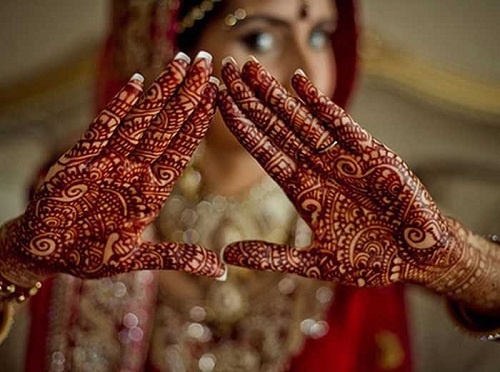FWP:
SETS == WORDPLAY
BONDAGE: {1,5}
HENNA:
{18,4}
For background see S. R. Faruqi's choices. For more on Ghalib's unpublished verses, see the discussion in {4,8x}. This verse is from a different, unpublished, formally identical ghazal,, and is included for comparison. On the presentation of verses from unpublished ghazals like this one along with formally identical divan ghazals, see {145,5x}.
On ordinary women's hands, the brilliant red designs made with henna lighten and eventually fade away. (For more on henna, see {18,4}.) But the beloved is no ordinary woman, of course. She's so constantly and effectively murderous that ever-fresh sprays of blood keep her hands perpetually patterned with henna-red. Thus the color doesn't have a chance to fade.
And since the verb for the fading of color is u;Rnaa , literally 'to fly', the henna becomes a small winged bird-like creature in the 'hand' (or 'claw', or clutch) of a ruthless captor. Because it can't 'fly' away, it must obviously have a string on its leg. Gyan Chand vouches for the colloquial phrase mur;G-e rishtah bar paa . Without the wordplay of u;Rnaa , could this verse even exist at all? For another verse about color and its 'taking flight', see {7,2}.
To turn blood into henna doesn't at all tax the powers of the beloved-- we see in {230,2} that she can easily turn a solid metal mirror into henna.
Zamin ties himself into a perverse knot in his commentary-- first seeking a 'natural poetry' origin for the verse, then rejecting his own proposed solution as 'meaningless'. Moral: ghazal verses not only don't need naturalistic, real-world sources, but most often can't even make any effective use of them them.

Zamin:
The color (bird) of the hands of the Hunter (that is, the beloved) cannot fly because a great deal of blood constantly keeps dripping. So to speak, the flow of blood is a continuous string that is attached to the foot of the bird of the color of henna, and does not let it fly. A bird is used as a simile for color because color 'flies'/fades.
But the question is, this blood that keeps continuously dripping-- where does it come from? Perhaps he will have seen some bird slaughtered by a henna-adorned hand, from which blood too was dripping-- and on it he molded this verse. If such is the case, then here by prey and Hunter, lover and beloved are not intended-- and if they are not, then the verse is meaningless.
== Zamin, p. 361